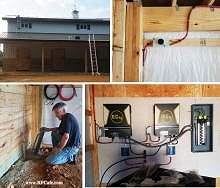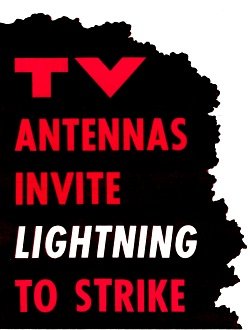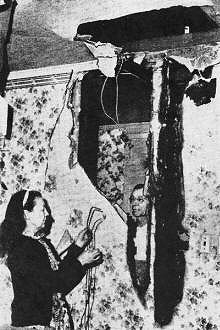|
October 1960 Radio-Electronics
 [Table of Contents] [Table of Contents]
Wax nostalgic about and learn from the history of early electronics.
See articles from Radio-Electronics,
published 1930-1988. All copyrights hereby acknowledged.
|

Photovoltaic (PV) system installation. This was the early
stage before the battery backup and AC wiring was completed. Everything worked
perfectly the first time it was turned on. I measure around 315 Vdc from
the PV arrays
on a sunny day.
The
Lightning Protection Institute (LPI)has
been around for a long time; in fact, it might have been informally founded by
Benjamin Franklin ;-) Last year while working on an installation plan for a
friend's solar panel array and equipment room, I found lots of useful info on
the LPI website for best practices of lightning protection. I was surprised to
learn that there was still disagreement among experts as to whether a raised,
grounded surface like the metal roof onto which the photovoltaic (PV) arrays
are mounted tended to reduce or increase the likelihood of a lightning strike.
There are good theoretical arguments on both sides. I tend to think the raised,
broad surface decreases the cloud-to-ground potential and disperses the charge
across a larger area, thus reducing chance of a strike. There is also
disagreement whether the ground for the PV array should be physically connected
to the ground point for the inverters and AC distribution panel. Thus far there
have been no problems, but luck plays a large part of it unless a full-scale
mitigation system is implemented, and that requires a lot of expensive rods,
bleeder lines, and ground stakes.
TV Antennas Invite Lightning to Strike
 By Lightning Protection Institute By Lightning Protection Institute
An increasing number of TV-related lightning
fires occur each year. Most could be prevented if proper grounding techniques were
used
If you're among the thousands who think that an ordinary television antenna
atop the roof is safe from lightning, you're wrong, says the Lightning Protection
Institute.
Studies of some 1,500 lightning-fire and damage losses, reported in newspapers
during a 3-month period, reveal that upward of 4% of them involve television sets
and their antennas. That's no small matter - $4,800,000 annually.
Those facts pointedly illustrate that an unprotected antenna actually invites
lightning to strike. There are more than 40,000,000 television masts in this country,
and it is inevitable that this forest of high-rising metal towers will help to increase
the losses suffered from lightning strikes - unless the masts are protected.
Total annual lightning losses in the US are placed at 600 persons killed, more
than 1,500 injured, along with $120,000,000 in property losses. Lightning is the
biggest single cause of fires in rural and outlying suburban areas, being responsible
for 37% of all such fires.
Tying the TV antenna into the home's lightning-protection system is one means
of helping to reduce losses. Where a building does not have a complete lightning
protection system, grounding the TV mast properly will only partially protect it.
To ground a TV antenna adequately, in addition to a 10-foot ground rod, tie-in should
be made to the water system, electrical and telephone grounds and any metallic bodies
within 6 feet of the down conductor. Ordinary TV installations in themselves are
inadequately grounded, and the antenna is not a lightning-protection device.

Lightning traveled "down" a TV lead-in and made a new entrance
for this kitchen.
Basic Information
Lightning will most likely strike the highest object in an area. Because of its
height above surrounding objects, the antenna becomes this most likely lightning
target.
A TV antenna, even though grounded according to most set manufacturers' recommendations
(and with a lightning arrester), does not offer sure lightning protection for the
set. It is not connected with a heavy enough cable nor does it provide the proper
paths to earth to function as an efficient lightning rod.
Most antennas, contrary to popular belief, do not have lightning arresters. And
an arrester is not full protection in itself - the mast must also be tied in with
the correct conductor cable to a ground rod sunk 10 feet deep in moist earth.
When lightning does hit an ungrounded antenna, its path is most likely to be
down through the house. It may leap over to the wiring system or water pipes, or
follow the antenna lead. At the least, you can expect damage to whatever mechanical
equipment the bolt, passes through (Many TV sets have ended in a ruined tangle of
wires) and at the worst, injury or death to occupants.
Scores of lightning losses involving TV antennas lead the Lightning Protection
Institute to endorse strongly this requirement in the Underwriters' Laboratories
code:
"Radio and television masts of metal, regardless of location on building, shall
be bonded with standard conductor and fittings to the main conductor of the lightning
protective system. It is also recommended that a lightning arrester be installed
on the lead-in wire, tape, or cable."
Where a television antenna is installed on a building provided with lightning
protection (a lightning-rod system), the metal mast or supporting tower should be
connected to the system. If the tower rises appreciably above the building, it should
also have a down conductor connecting it directly to ground to conform to National
Bureau of Standards requirements.

Mast should be grounded to copper rod sunk into moist earth.
Alternate Method
Where a building is not provided with a complete lightning protection system,
and safety with economy is the watchword, the institute advises full protection
of the TV antenna and set. This will partially protect the building proper. This
is recommended on the premise that some protection is better than no protection
at all.
If the TV antenna is centrally located, grounding the mast can be tied in with
complete lightning protection for the home by continuing the cable in both directions
(and adding terminals at 20-foot intervals if the building is 40 feet or longer)
from the TV mast along the roof ridge and down to ground on two sides of the building.
This is not a job for the usual TV installation man. Considering the danger to life
and property, the importance of trained engineering skill becomes even more vital.
Don't hesitate to seek professional help or advice in all instances, whether for
protecting a TV set, and antenna or for a complete lightning-protection system.
However, if the antenna is at either end of the building, the TV mast alone is comparatively
simple.
The drawing illustrates how the lightning arrester is connected to the TV lead-in
and then fastened to the mast with an approved pipe clamp (which generally comes
with the arrester). Many good arresters are on the market; the important thing to
watch for is the Underwriters' Laboratories label.
The drawing also illustrates how the ground cable is connected to the TV mast,
using a UL-approved cable clamp.
The ground cable is run from the connection at the mast, along the roof ridge
(hidden by placement along ridge rolls), down the gable side (hidden under eave),
then down the building side.
There are several rules governing cable installation. The cable shall have no
bends sharper than 90°. The radii of all curves should be at least 8 inches.
Lightning, with its sudden rise time, will not travel through a cable that has sharp
bends if it can find a shorter path to ground (a jump across several feet to a water
pipe is not uncommon). The cable is to be supported every 3 feet on open-air runs,
and maintain a horizontal or downward course, free from down and up (V or U) pockets.
The cable is connected to an approved ground rod with a standard ground-rod clamp.
The ground rod is driven 10 feet into permanently moist soil, at least 2 feet away
from the house foundation.
Standard Materials
Copper and aluminum are acceptable materials for lightning-protection systems,
but should never be used together without special connectors. Aluminum parts must
be larger than equivalent copper parts for equal conductivity.
The copper cable should weigh at least 187.5 pounds per 1,000 feet (individual
wires making up the cable should be at least of No. 17 gauge). This cable is three
times the size of a No.6 cable which most manufacturers and installers recommend.
Aluminum cable should weigh at least 95 pounds for the same length.
Ground rods, solid copper or copper-clad, should be at least 1/2 inch in diameter
and 10 feet long.
Connectors and fasteners must be of the same material as the cable. Galvanized
or plated-steel nails, screws or bolts are not acceptable on copper or aluminum
installations.
Service Available
The Lightning Protection Institute, a non-profit Chicago organization, offers
its help whenever it is needed by anyone - home owners, plant engineers, organizations
or individuals. Sponsored by reputable, long-established lightning-equipment manufacturers,
the institute was set up to promote the science and improve the methods of lightning
protection (and to advise and give information) .
Another of its purposes is to formulate and press for the practice of ethical
standards in all phases of the lightning-protection industry. In this role, it works
toward the goal of full inspection and official approval of all lightning-protection
systems, new or old.
While the institute does not take any part in actual equipment testing or field
inspections of installers and their work, the group works closely with Underwriters'
Laboratories.
If you plan to protect your TV antenna and set, entire home or plant against
lightning and there is any question regarding materials or installation, the best
way to get the answer is to write to the Lightning Protection Institute, 53 W. Jackson
Blvd., Chicago 4, Illinois, for Lightning Facts and Figures.
Posted July 5, 2024
|





























 By Lightning Protection Institute
By Lightning Protection Institute

